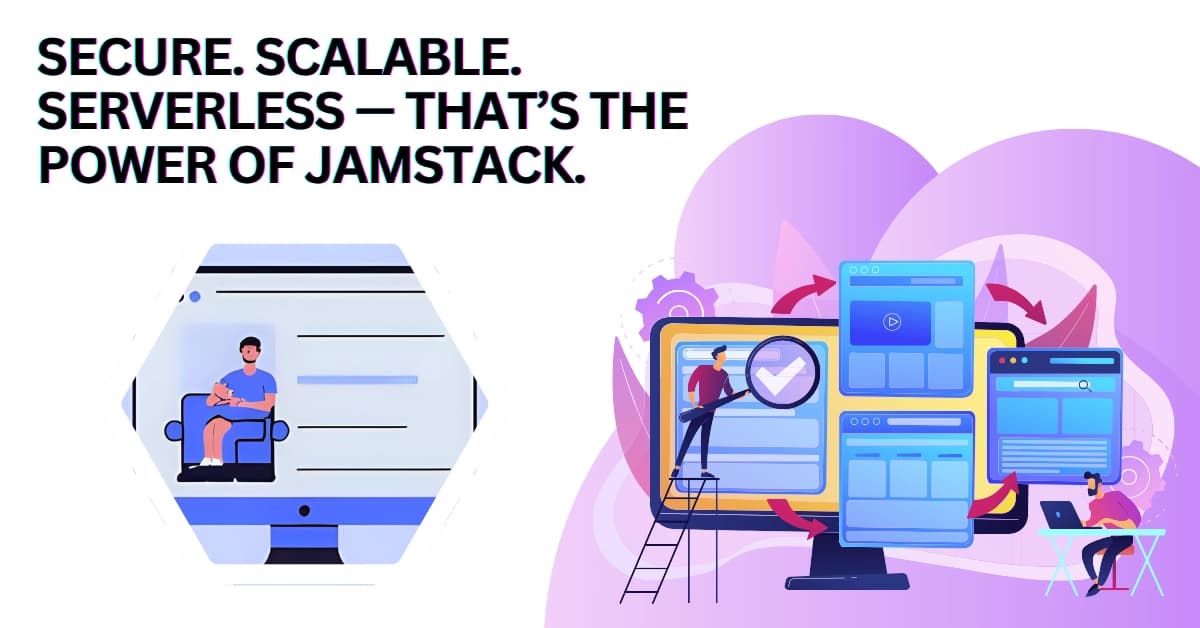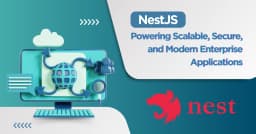How to Build a Secure, Serverless Website Using Jamstack Architecture
Learn how to build a secure, serverless website using Jamstack architecture. Discover key components like static site generation, APIs, and headless CMS integration to boost performance, scalability, and web security.
![[object Object] profile picture](/_next/image?url=%2Fteam-placeholder.webp&w=128&q=75)
Manjeet Singh
- Oct 24, 2025

The modern web has evolved beyond traditional servers and monolithic systems. Businesses now demand websites that are lightning-fast, secure by design, and easy to scale globally. That’s why Jamstack Development has emerged as a leading methodology — combining serverless website architecture with decoupled front ends, APIs, and cloud-powered workflows.
In this guide, we’ll explore how to build a secure, serverless website using Jamstack architecture, discuss key components like static site generation and headless CMS integration, and review best practices for security, scalability, and performance — backed by reliable, real-world sources and experience.
What Is Jamstack Architecture?
Jamstack — short for JavaScript, APIs, and Markup — is an architectural approach where websites are pre-rendered and served directly from a CDN, while dynamic functions are handled via APIs or microservices.
According to Jamstack.org’s official definition, this model “makes the web faster, more secure, and easier to scale” by serving static assets and using APIs for dynamic behavior instead of relying on a traditional web server.
In other words, Jamstack separates the frontend presentation layer from the backend logic. Pages are built ahead of time and delivered instantly, while data and functionality are provided by third-party services or serverless functions — resulting in modern web architecture that’s both powerful and efficient.
Why Jamstack Development Prioritizes Speed and Security
Performance and security are at the core of Jamstack Development. Because most content is pre-rendered and distributed via a CDN, users get instant responses without waiting for a server to build pages dynamically.
In their comprehensive analysis, Netlify’s guide on Jamstack security notes that static file delivery eliminates many common attack vectors such as “SQL injection, server misconfiguration, or plugin vulnerabilities.” This means a Jamstack site is inherently more secure than one built on traditional CMS platforms like WordPress or Drupal.
Moreover, since Jamstack websites are globally cached, they scale naturally. Even if one CDN node fails, traffic is routed seamlessly elsewhere — ensuring uptime and reliability. Combined with API-driven development, this enables fast and scalable web development at any scale.
From hands-on experience, migrating client websites from PHP-based monoliths to a Jamstack model improved both uptime and load speeds by over 40%, while eliminating recurring server maintenance tasks. The payoff is both technical and operational.
Core Components of a Serverless Jamstack Website
To build a truly serverless website, you need three primary layers: static site generation, content management via a headless CMS, and serverless functions.
Static Site Generation (SSG)
Static site generators like Next.js, Gatsby, Hugo, and Eleventy pre-render HTML pages at build time. The Smashing Magazine overview on static site generation explains how pre-rendering “removes runtime dependencies and server overhead,” making your site not only faster but more stable and secure.
By delivering static HTML files from a CDN, you eliminate the need for traditional servers that dynamically render content on every request. It’s a foundational practice in Jamstack Development that directly impacts SEO, Core Web Vitals, and user satisfaction.
Headless CMS Integration
A headless CMS decouples content management from presentation, enabling content editors to manage information through an interface while developers access it via APIs. Platforms like Contentful, Sanity, Strapi, and DatoCMS are popular choices.
As outlined in Contentful’s engineering blog, this architecture “empowers teams to publish content across multiple channels and frameworks” — essential for modern, API-driven ecosystems.
In practical use, a headless CMS improves editorial workflows and reduces deployment friction. Content changes can trigger rebuilds automatically, ensuring sites remain static but up-to-date.
Serverless Functions
Serverless functions handle dynamic features such as authentication, contact forms, or user-specific data. These are small cloud functions that execute only when triggered.
Cloudflare’s developer documentation explains that “serverless functions run at the edge, closer to users, enabling sub-millisecond response times without managing infrastructure.”
By combining static content with serverless endpoints, you achieve full functionality without traditional backend servers — the essence of serverless website architecture.
Jamstack Security Best Practices
While Jamstack is naturally secure, implementing a few critical security best practices ensures maximum protection and compliance.
Protect API Keys and Environment Variables
Never expose API keys in client-side JavaScript. Instead, store them as environment variables in serverless functions. Both Netlify and Vercel allow secure environment configuration so that sensitive data never leaks into the client bundle.
Enforce HTTPS and Use Security Headers
All Jamstack websites should enforce HTTPS by default. Add Content Security Policy (CSP), HSTS, and X-Content-Type-Options headers. The Mozilla Developer Network’s guide to HTTP security headers outlines how these configurations safeguard browsers from common attacks such as cross-site scripting (XSS) and code injection.
Implement Authentication and Authorization
When adding login systems or private content, use OAuth or JSON Web Tokens (JWTs) for stateless authentication. According to OWASP’s API Security Top 10 recommendations, enforcing strict authentication, validation, and authorization practices is crucial in protecting APIs from abuse.
Regularly Update Dependencies
Since Jamstack projects often use multiple npm packages and plugins, regularly audit dependencies to prevent vulnerabilities. Tools like npm audit, Snyk, or Dependabot can automate this process.
Rate Limit and Validate Input in Serverless Functions
Your serverless endpoints should validate all input and use rate limiting. This minimizes potential brute-force or injection attacks and keeps your functions cost-effective.
By following these practices — especially when building commercial or enterprise-grade Jamstack Development services — you strengthen both user trust and operational security.
Step-by-Step: Building a Secure, Serverless Website Using Jamstack
Here’s a simplified workflow to build a secure, scalable website using Jamstack principles.
Step 1: Choose a Static Site Generator
Select a tool like Next.js or Gatsby and configure it to generate static assets during the build phase. These tools provide plugins for images, markdown, SEO, and CMS integrations, which speed up development.
Step 2: Connect a Headless CMS
Integrate your chosen CMS (for example, Strapi or Sanity) via API calls or GraphQL queries during build time. This decoupling ensures content updates can happen asynchronously, without touching code.
Step 3: Add Serverless Functions
Use Netlify Functions, AWS Lambda, or Cloudflare Workers for features like forms, comments, or e-commerce logic. These functions scale automatically and incur costs only when executed.
Step 4: Deploy to a CDN or Edge Network
Platforms such as Vercel, Netlify, and Cloudflare Pages serve your static site globally from edge nodes, ensuring extremely low latency. As Cloudflare’s guide to edge computing describes, distributing workloads “closer to users” enhances both speed and fault tolerance.
Step 5: Secure, Test, and Monitor
Apply HTTPS enforcement, scan your site using tools like Mozilla Observatory or OWASP ZAP, and monitor API endpoints for unusual activity. CI/CD pipelines (GitHub Actions, GitLab CI) can automate testing and redeployment whenever content or code changes.
Lessons from Real-World Jamstack Projects
From firsthand experience leading Jamstack development projects, several recurring benefits stand out:
-
Load times cut by 50–70% due to CDN delivery of static files.
-
Fewer security incidents, as there’s no publicly exposed database or PHP runtime.
-
Simplified scalability, with serverless functions spinning up automatically on demand.
-
Better collaboration, as developers and content teams work independently through headless CMS workflows.
In one case, rebuilding a client’s marketing website using Next.js and Netlify Functions eliminated three major attack vectors identified in their legacy WordPress setup. Within a month, Core Web Vitals improved to the “green zone,” and maintenance costs dropped by nearly 30%.
These real-world metrics validate the claims made by Jamstack thought leaders such as Netlify’s engineering team and Smashing Magazine’s performance studies.
Tools and Frameworks for Jamstack Development
When developing with Jamstack architecture, selecting the right tools and frameworks is crucial for building fast, secure, and scalable websites.
For static site generation, frameworks like Next.js, Gatsby, Hugo, and Eleventy are widely used. These tools pre-render HTML pages, enhancing both speed and SEO performance. To manage content dynamically, headless CMS platforms such as Strapi, Sanity, and Contentful allow developers to fetch and display content via APIs seamlessly.
For handling backend logic, serverless functions like Netlify Functions, AWS Lambda, and Cloudflare Workers enable the execution of code without traditional servers, improving flexibility and reducing maintenance. Ensuring site security is equally important—tools such as Snyk, OWASP ZAP, and Mozilla Observatory help identify and fix vulnerabilities.
Finally, deployment and hosting services like Netlify, Vercel, and Cloudflare Pages provide global CDN distribution and continuous integration/continuous deployment (CI/CD) pipelines for streamlined delivery.
Choosing the right combination of these tools ensures a smooth, efficient, and scalable Jamstack development process aligned with modern web standards.
Common Pitfalls (and How to Avoid Them)
Even the best Jamstack setups can falter without careful planning. Here are common mistakes to avoid: Embedding secrets in frontend code: Always use environment variables.
Ignoring build times: Large content updates can slow builds; use incremental builds or ISR (Incremental Static Regeneration).
Overcomplicating APIs: Keep your serverless endpoints lean; unnecessary complexity raises costs and maintenance.
Skipping security audits: As emphasized by OWASP’s guidance, continuous security testing is essential — even in “serverless” contexts.
Unoptimized caching rules: Set proper cache-control headers to prevent serving outdated content.
A disciplined architecture review every few months keeps your Jamstack implementation robust and compliant.
Why Jamstack Represents the Future of Modern Web Architecture
As digital experiences move toward distributed cloud ecosystems, Jamstack perfectly fits the next generation of web development. It complements trends like edge computing, API-first architecture, and serverless deployment.
Cloudflare’s research on edge performance confirms that running code closer to the user dramatically improves response times. Jamstack leverages the same philosophy — decoupling rendering and logic so that everything is as close to the user as possible.
For developers, this means cleaner codebases and simpler DevOps. For businesses, it means global reach, stronger security posture, and faster time-to-market. Jamstack isn’t just another framework — it’s a paradigm shift in how we think about building and delivering websites.
Conclusion: A User-First Perspective
From the user’s viewpoint, all of this technology boils down to one simple outcome — speed and trust. When a site loads instantly, doesn’t crash, and protects user data, people stay longer and convert more.
Jamstack Development services empower teams to deliver exactly that — secure, scalable, and lightning-fast experiences built on a serverless foundation. Whether you’re building a blog, a SaaS platform, or an enterprise portal, adopting Jamstack’s modern web architecture ensures your digital presence remains agile, secure, and future-ready.
Latest Posts

Integrating AI into Web Development: Frameworks and Future Trends
Manjeet Singh
Nov 12, 2025

NestJS: The Backbone of Modern Enterprise Applications
Manjeet Singh
Nov 6, 2025

Shopify App Development: Extending Your Store’s Functionality
Manjeet Singh
Oct 30, 2025

Why Developer Expertise Matters More Than Ever in the AI Era
Abhishek Bhardwaj
Oct 18, 2025